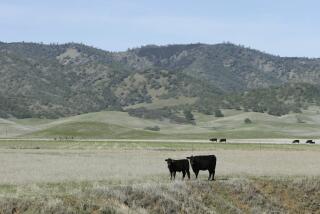Is Hetch Hetchy a Sacrificial Offering? : Dam-Razing Proposal May Be Hodel Ploy for Respectability
- Share via
Northern California’s Hetch Hetchy water system is arguably among the engineering marvels of the United States. Completed in 1934, it cost $100 million and the lives of 67 men and one woman. Its appreciated value in today’s dollars runs into the billions.
It took more than 20 years to construct the three dams, five major reservoirs, three hydroelectric-power plants, 89 miles of aqueduct pipeline and 66 miles of tunnels--including the 29-mile Coast Range bore, at the time the longest tunnel in the world. Today the Hetch Hetchy system is functioning perfectly and paying for itself.
A masterpiece of engineering, bringing the waters of the Sierra to the San Francisco Bay Area by gravity alone, the Hetch Hetchy can be expected to last for hundreds of years.
More than one-third of the San Francisco Bay Area’s population--the fourth-largest urban region in the country--depends on Hetch Hetchy for water. With its vast capacity and delivery system, which could easily be integrated into California’s north-south water lines, the Hetch Hetchy also functions as a valuable hedge against that drought that ever haunts the collective imagination of our massively irrigated society.
A week or so ago, Secretary of the Interior Donald P. Hodel sat before his word processor and, we are told, with his own fingers tapped out a memo suggesting that O’Shaughnessy Dam, the linchpin of the Hetch Hetchy system, be demolished. The Hetch Hetchy reservoir, the secretary recommended, should be drained, and the Hetch Hetchy valley be reforested as a public park to relieve pressure on the Yosemite Valley.
The proposed Auburn Dam, the secretary suggested, could be utilized to meet Bay Area water needs.
Incredibly, Hodel’s proposal--so unnecessary, so wasteful, so irresponsible--is being taken seriously in some quarters, or is at least being entertained as plausible.
Portions of the environmental community, for one thing, have never ceased to mourn the loss of Hetch Hetchy Valley to a reservoir.
John Muir called the Hetch Hetchy the Little Yosemite. The great naturalist led the fierce opposition to the project and, it is said, died of a broken heart when he was defeated. Hetch Hetchy Valley was tragically sacrificed in the creation of the water system.
German philosopher Georg Hegel suggested that tragedy is not so much the conflict between good and evil as it is the conflict of good versus good. The good of the Hetch Hetchy Valley was sacrificed for the urbanization of the San Francisco Peninsula. It was a trade-off, tragic in its consequences for the valley but necessary for the growth of the Bay Area. Los Angeles experienced the same mixed result when its aqueduct began to dry up the Owens Valley in the 1920s.
Some environmentalists have never accepted the Raker Act of 1913, which authorized the damming of the Hetch Hetchy. But is Hodel himself such an extreme environmentalist?
To answer this question one must first deal with the irrationality of his proposal. The municipally owned and operated Hetch Hetchy is working and paid for. The federal Bureau of Reclamation’s Auburn Dam, by contrast, which Hodel proposes as a substitute, has been stalled for years because it is too expensive and is growing even more so, and because environmentalists oppose it with the same ferocity with which they opposed the Hetch Hetchy project in 1913. It is therefore absurd even to suggest replacing a working dam with a dam that has very little chance of being built.
Is this, then, why Hodel has made his recommendation: to get the stalled Auburn Dam going again? Is he trying to buy off the opposition of the environmentalists by trading Hetch Hetchy for Auburn?
On a deeper level, is the secretary getting fatigued from the flak that must inevitably come from being the nation’s No. 1 environmental officer in an Administration whose environmental philosophy drives militant environmentalists mad with desperation? Does Hodel want to employ the Hetch Hetchy as a sacrificial offering, using this absurd suggestion to buy respectability among militant environmentalists?
Is the secretary’s stated aim--the restoration of the Hetch Hetchy as a public park to handle pressure on Yosemite--worth such an enormous expenditure of money? Would it not be more prudent to encourage better usage of state and national park systems, so woefully underutilized outside such major attractions as Yosemite, Grand Canyon and Yellowstone?
Can a society faced with, among other things, an impending crisis of caring for dying AIDS patients--a crisis that will soon threaten the public-health structures of our nation--afford so cavalierly to spend $6 billion to replace a perfectly functioning Hetch Hetchy system? Are the school systems, the libraries, the transportation systems of our nation so perfectly functioning that they could not be helped by the infusion of $6 billion?
In a response common to Washingtonians, Hodel is seeking to please a special interest, the militant environmentalists. To their credit, however, even militant environmentalists have never in their wildest dreams proposed that the Hetch Hetchy be dismantled.
More to Read
Sign up for Essential California
The most important California stories and recommendations in your inbox every morning.
You may occasionally receive promotional content from the Los Angeles Times.









